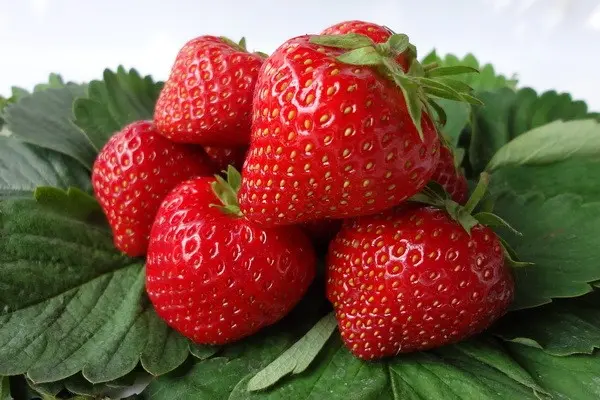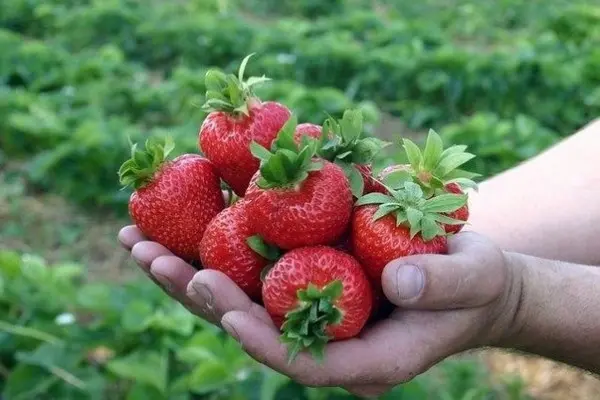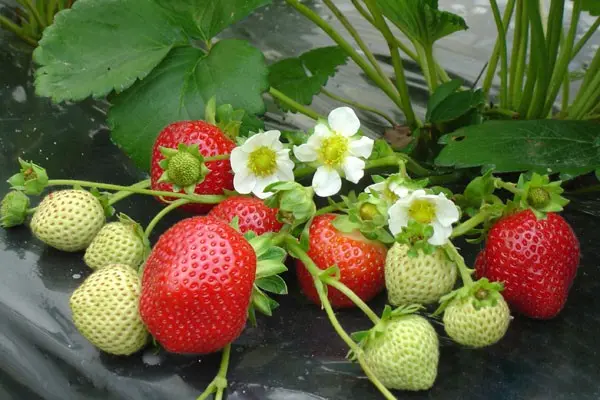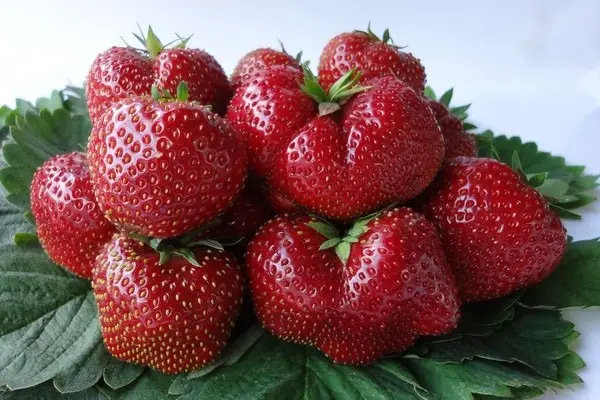The main difference between the Dutch varieties Wim Zant and Xima is the ripening period. If Vima Zanta leads the ranks of early varieties, then you won’t get berries from Vima Xim’s strawberries before July. But all these varieties are the result of the fruitful selection work of the leading scientists of the Dutch company Vissers.
Vima Zant
This variety will surprise you with large, bright red berries. And you can recognize them immediately by the distinctive matte color. The shape of the berries can be different and change with each harvest: if during the first harvest you see round berries, then the next time you will have to collect cone-shaped ones, slightly flattened on the sides. If you provide strawberries with good care and weather conditions do not let you down, you will get sweet, juicy berries with a wonderful strawberry flavor.
The height of the strawberry stems is medium, and the bushes themselves are quite powerful. If we talk about flower stalks, then they are thin, and fall down under the weight of large berries. The disadvantages of the variety include poor transportability: the fruits quickly come off the sepals, their flesh is very juicy, but, unfortunately, loose.
Among the main advantages of Wim Zant are a good yield of 10-15 t/ha, as well as excellent drought tolerance. The variety perfectly resists diseases and pests such as gray rot, verticillium, fusarium, as well as other fungal or viral diseases. But it must be emphasized that Vima Zanta is sensitive to powdery mildew.
Ripening period – medium early, winter hardiness – medium. Having bought even a small number of bushes, you can easily propagate plants, because a lot of mustache develops. But still, in order to grow a decent strawberry garden, do not forget about the obligatory feeding of the plant with nitrogen, as well as organic fertilizers towards the end of March and phosphate-potassium in early May.
Vima Xima
We hasten to inform lovers of large-fruited varieties that the regiment of strawberry giants was replenished with another variety. It was bred quite by accident, so there is no pedigree in strawberries. But, despite this fact, many gardeners have already managed to appreciate all the advantages of this variety.
Strawberries can boast of a solid size of berries. Indeed, those gardeners who grow the Vima Xima variety on their beds can only be surprised at the size of the fruit, the weight of which can be from 60 to 120. The color of the berries is dark red, the shape is cone-shaped or comb-shaped. The taste of the fruit is sweet and sour, the fragrant pulp has a barely noticeable strawberry aroma.
Strawberries perfectly withstand transportation, tolerate storage well. Refers to varieties of medium late ripening. The yield of strawberries is 700 g. The bushes are powerful and strong. There are many leaves, their color is juicy, dark green. Peduncles are rough, so the weight of large berries can withstand well and do not lean. Many mustaches from plants of this variety should not be expected.
The variety tolerates low temperatures, as well as drought, with firmness, which makes it possible to grow it in a variety of climatic conditions. Wim Xima can also please with excellent resistance to many diseases. But you should not relax, because in any case you must provide the plants with good care, otherwise, under bad weather conditions (for example, if the summer is too rainy), gray rot may appear.
Since the plant gives little mustache, the main method of reproduction is the division of the mother bush. The variety is unpretentious, but still it needs regular and balanced feeding, wide seating and thinning of the bushes.
Vima Tarda
Tarda is a great successor to the Vima series. She was bred as a result of crossing Vikoda and Wim Zanta varieties. And the fruit of the painstaking work of Dutch breeders was a plant with large berries, the average weight of which is 40 grams.
The color of the berries is dark red, the tip is yellow. They can be recognized by their distinctive luster, as well as their amazing sweet taste and unique aroma. Strawberries have a high level of transportability, the range of application is quite wide.
Wima Tarda belongs to late varieties with a high yield of 10 t/ha. Bushes of plants are powerful, sprawling, the crown is wide. The leaves grow dark green, with a slight glossy sheen. Peduncles withstand the weight of the fruit well and do not bend under the weight of the berries.
The main advantages of this variety are excellent indicators of winter hardiness, as well as drought resistance.
If you carry out all the necessary preventive treatments from a variety of pests (for example, a kidney mite), then there will be no problems with plant diseases.
Variety Wima Tarda is quite unpretentious, but the maximum return can be achieved only with regular feeding and compliance with water and temperature conditions.
Vima Rome
Those gardeners who managed to make friends with the Vima Rome variety speak very positively about this friendship. Strawberries grow in powerful densely leafy semi-spreading bushes. The size of the leaves is medium, and the color is light green. The berries are quite large – with good care and favorable weather conditions, the weight of the fruit can reach 50 grams. The shape of the berries is conical, painted in bright red with a noticeable sheen. Strawberries are excellent for transporting, despite the fact that the pulp is very juicy and tender. The taste of berries is rich. Plants do not give many mustaches.
The main characteristics due to which the variety has won the sympathy of many gardeners are winter hardiness, heat resistance, as well as high complex resistance to many diseases. Berries can be consumed fresh, but they are also actively and successfully used for technical processing. When preserved, they perfectly retain the main part of the nutrients.
The yield of the Vima Rima variety is amazing: the first berries can be picked from the bushes already in early June, but the plants continue to bear fruit right up to the first frost in the fall. But you can go to the trick and extend the fruiting season by providing the bushes with the appropriate conditions. Therefore, if you protect the soil well, then strawberries can give berries until November.
From the description of the varieties Wim Zant and Xima, we can conclude that in a rainy climate, strawberries lose their taste and are subject to various diseases. It is also important to emphasize that the level of transportability of Wim Zant is lower than others, which is why most gardeners use plants as strawberries “for themselves”.
Video “Growing strawberries all year round”
An entry on how to care for and grow strawberries at home in a pot.









